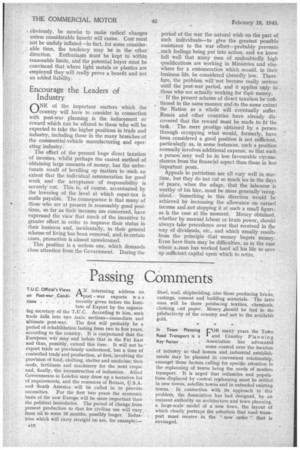Passing Comments
Page 14

Page 15

If you've noticed an error in this article please click here to report it so we can fix it.
T.U.C. Official's Views A N interesting address on on Post-war CondiImpost war exports w a s tions recently given before the Institute of Export by the organizing secretary of the T.U.C. According to him, such trade falls into two main sections—immediate and
ultimate post-war. The first will probably be a period of rehabilitation lasting from two to five years, according to the country. It is conjectured that the European wAr may end before that in the Far East and thus, possibly, extend this time. It will not be export trade as previously understood, but a time of controlled tr-ade and production, at first, involving the provision of food, clothing, shelter and medicine; then seeds, fertilizers and machinery for the next crops; and, finally, the reconstruction of industries. Allied Governments in London may draw up a tentative list of requirements, and the resources of Britain, U.S.A. and •South America will be called in to provide
necessities. For the first two years the economic basis of the new Europe will be more important than the political boundaries. The period of change from present production to that for civilian use will vary from nil to some 18 months, possibly longer. Industries which will carry straight On are, for example;
Steel, coal, shipbuilding, also those producing bricks, castings, cement and building materials. 'The later ones will be those producing textiles, chemicals, clothing r.nd paper. Money ,should be tied to the pfbductivity of the country and not to the available gold.
FOR many years the Titm
crand Country Planning Association has advocated some control over the location of industry so thaf homes and ,industrial establishments may be planned in convenient relationship, amongst those factors calling for specific attention in the replanning of towns being the needs of modern transport. It is urged that industries and populations displaced by central replanning must be settled in new towns, satellite towns and in extended existing towns. In connection with its approach to this problem, the Association has had designed, by an eminent authority on architecture and town planning, a large-scale model of a new town, the layout of which clearly portrays the attention that road transport must receive in the " new order" that is envisaged.
In Town Planning Road Transport is a Key Factor . . . .
Buses Larger Turning ' THE fitting of oversize tyres Circle for Oversize I to certain doubledeck buses has resulted in increasing their turning circle ,so that it is in excess of the maximum of 60-ft.. diameter prescribed in the appropriate regulations. To cover this war-time measure, Regional Transport Commissioners have been advised that, when dealing with applications for defence permits to use such vehicles, they should not be withheld merely for this reason.
Tyres
Judge Disposes of Old T'HERE are special points Defence in Ballast I deserving attention concern Case ing a recent case in which a sand and ballast merchant was sentenced to 18 months' imprisonment for delivering short ineasure. Hitherto, it has Sometimes been considered a good defence if an accused could argue that a. vehicle was loaded with a greater quantity than was actually shown on the pit ticket, and was therefore justified in charging for such quantity on his conveyance note. The judge, however, shattered this defence. He argued that if a quantity in excess be taken from the pit and not paid for, there would be clear evidence of fraud. Another point is that the Weights and Measures Act (1936) requires those who sell materials by the cubic yard to be able to measure the quantity by means of a calibration mark. Obviously, a vehicle calibrated for 4 cubic yds. cannot legally be used for conveying 5, even if the old and unsatisfactory method of heaping loads be employed. .
More Methods to HE search for paper for sal Help the Salvage of I vage brings many surprises. Paper For example, that in which the workers at Fort Dunlop brought their lunches to the works canteen during the past year was found to weigh more than 24 tons out of a total of just over 194 tons collected for salvage during this period. Daily papers and weeklies, together with office paper, contributed more than 58 tons, and there were nearly 102 tons of cardboard. Apart from this salvage, many more tons were saved by straightening out old brown paper and using it again for wrapping, by the return of [tacking to suppliers, and by employing the plain side of used stationery.




















































